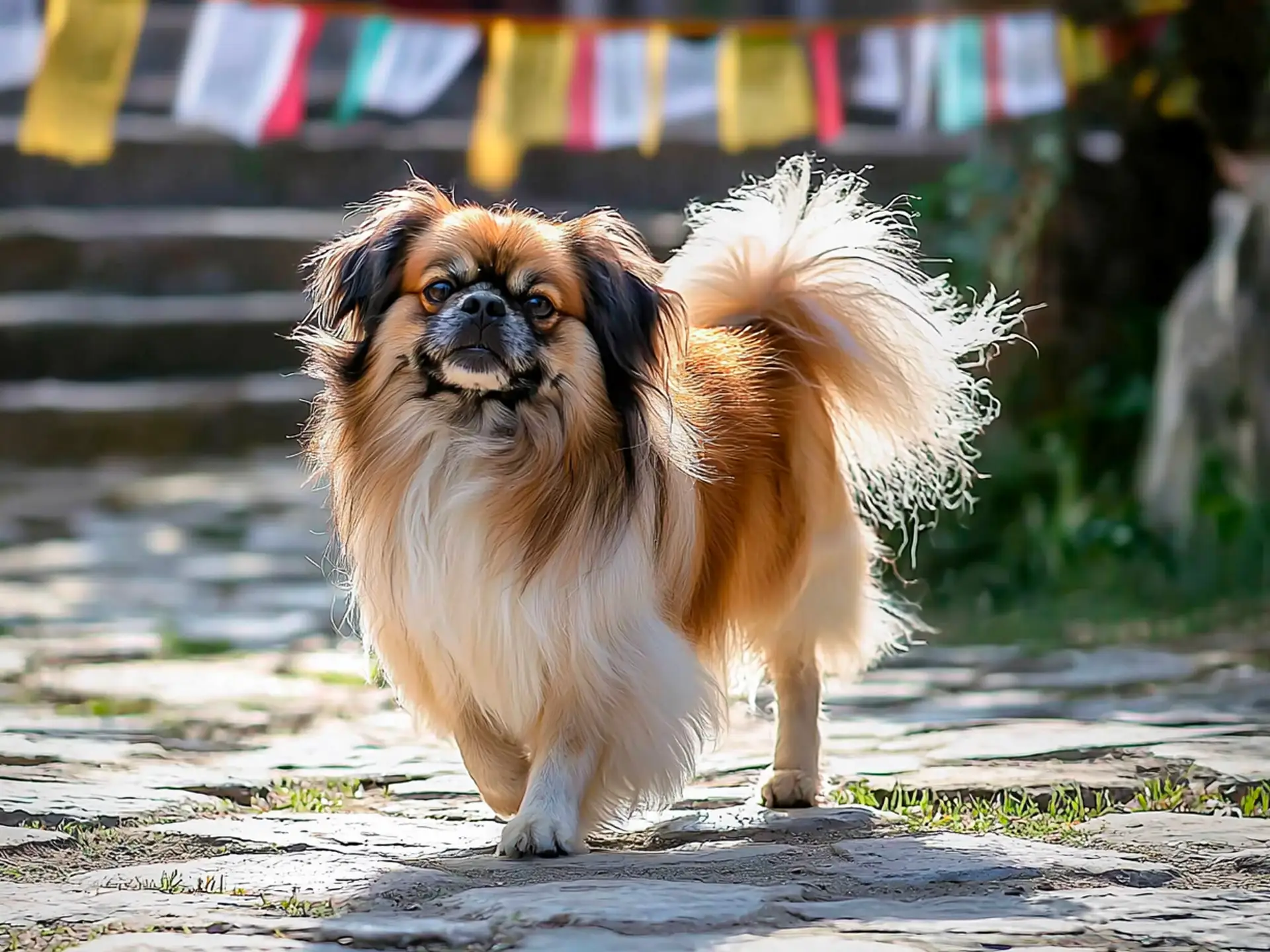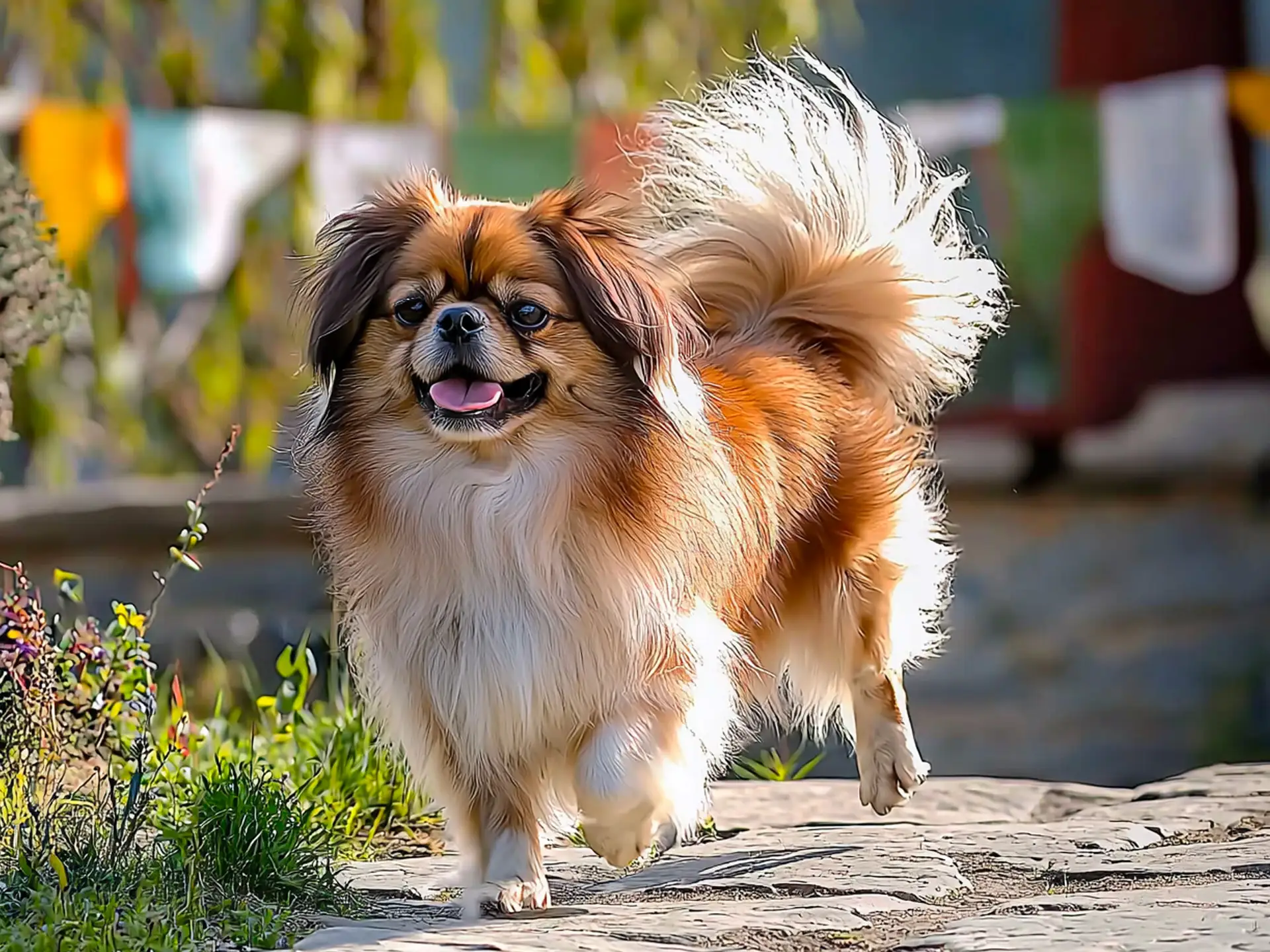Tibetan Spaniel Dog Breed Info & Overview
Did you know that the Tibetan Spaniel was once a treasured companion in ancient monasteries? This petite canine exudes a regal charm and boasts a playful spirit that belies its noble heritage. Known for their catlike independence, these clever pups form strong bonds with their people, making them a loyal and delightful addition to many households.
Characteristics
Pictures
Breed History
Tibetan Spaniels trace their beginnings back to the Himalayan mountains, where they served as sentinels and companions in monasteries. Monks cherished them for their alert nature and warm presence, often perched on high walls to oversee the surroundings. This heritage helped shape the breed’s keen senses and endearing loyalty, qualities that still shine through in modern times.
Legend has it these petite watchdogs were gifted to visiting nobles and monks, helping spread their popularity beyond Tibet. Because of their keen eyesight and attentiveness, they played the role of both companion and protector. Over time, their status as temple treasures evolved into beloved household pets, further cementing their reputation for adaptability and devotion.
The Tibetan Spaniel as we know it today has gradually gained recognition worldwide, prized for its unique history and lively disposition. Although not as widespread as some breeds, it maintains an enthusiastic following, especially among those seeking a faithful, pint-sized guardian. Their status as living relics of ancient Tibetan culture adds to the breed’s timeless appeal.
Temperament, Personality
With a dash of regal confidence and a sprinkle of independent thinking, these dogs bring an irresistibly quirky vibe to any home. They can be quite affectionate once they form a bond, yet they also appreciate their own space. Thanks to centuries of guarding monastic walls, they remain vigilant, making them exceptional little lookouts.
Despite their watchful nature, they often harbor a sweet, playful streak that shines around those they trust. Many owners compare them to cats, noting their penchant for high vantage points and an uncanny knack for reading human emotions. Given gentle handling and socialization, they can adapt well to children or other pets, though they may still keep a subtle air of independence.
A Tibetan Spaniel typically craves close companionship but isn’t overly clingy, striking a pleasant balance for many dog lovers. While they may be reserved around strangers at first, patience and positive introductions can reveal their sociable side. This mix of devotion, curiosity, and occasional stubbornness makes them a captivating addition to varied households.
Physical Characteristics
Compact and well-proportioned, these dogs stand roughly 10 inches (25 cm) tall and weigh between 9 and 15 pounds (4–7 kg). Their silhouette is slightly longer than it is tall, contributing to a balanced, yet nimble appearance. A plumed tail curls gracefully over the back, adding an extra layer of elegance to their already charming look.
Their distinctive head shape features a blunt muzzle and expressive eyes that exude intelligence and warmth. Many sport a mane of longer fur around the neck and chest—often referred to as a ‘shawl’—which accentuates their regal bearing. The coat itself can be found in a variety of colors, from solid shades to striking parti-color patterns.
In general, a Tibetan Spaniel’s thick double coat provides insulation against chilly conditions, reflecting its mountain origins. Though petite, these pups carry themselves with surprising confidence, prancing about with a light, agile gait. The combination of their luxuriant coat, alert expression, and proud stance truly sets them apart from other small dog breeds.
Health Issues
While generally healthy, this breed can experience certain genetic concerns, including progressive retinal atrophy (PRA), which affects vision over time. Regular vet check-ups and early screening can help detect such issues before they worsen. Patellar luxation, a condition where the kneecap occasionally slips out of place, is another ailment that owners should monitor.
Respiratory problems can sometimes arise due to their short muzzle structure, making hot or humid environments potentially challenging. Keeping them cool and avoiding strenuous activities during peak heat hours can help. Additionally, maintaining a clean and debris-free environment around their eyes is crucial, as the breed’s facial structure can make them more susceptible to eye irritations.
Overall, a Tibetan Spaniel benefits from routine health checks, balanced nutrition, and a moderate exercise regimen. Many lead long, active lives well into their teens when provided attentive care. By staying informed about breed-specific risks and consulting with a knowledgeable veterinarian, owners can give these unique dogs the healthiest life possible.
Grooming Needs
Although their coats may look lavish, grooming isn’t as intimidating as it might seem. Weekly brushing typically suffices to keep tangles and loose fur under control, especially around the mane and feathered areas. A slicker brush can help reach the undercoat, while a metal comb is handy for finishing touches and spotting any hidden mats.
During seasonal shedding, more frequent brushing may be necessary to prevent fur from taking over your living space. Pay close attention to the ears and tail, as these areas can be prone to knots and debris. Trimming the fur between paw pads can also prevent slipping on smooth surfaces and reduce tracked-in dirt.
When bath time rolls around, be sure to use a gentle dog shampoo suited for a double coat, followed by thorough drying to avoid damp spots on the skin. Overall, a Tibetan Spaniel needs moderate upkeep, but their splendid appearance and minimal doggy odor make grooming sessions well worth the effort.
Exercise Requirements
Despite their small stature, these pups enjoy daily walks and light play sessions to keep them mentally and physically stimulated. Roughly 30 minutes of balanced activity, broken into shorter segments, can suffice for most. Activities like puzzle toys, short fetch games, or leisurely strolls help burn off energy while also nurturing their inquisitive nature.
Due to their history of surveying monastic grounds from above, they relish a good vantage point rather than extended running sessions. However, that doesn’t mean they’ll shy away from exploring safe, enclosed areas. With the right encouragement, they’ll happily trot alongside you, but be prepared for them to take occasional breaks and observe the scenery.
A Tibetan Spaniel typically prefers consistent but moderate exercise over intense workouts. While they don’t demand marathon adventures, daily engagement fosters healthy muscles and prevents boredom. Tailoring their exercise routine to their individual personality and energy level ensures a well-balanced, content companion.
Training Tips
Training these bright dogs can be an interesting challenge. Their intelligence and occasional stubborn streak mean they quickly grasp basic commands but may test boundaries if not kept motivated. Using short, varied training sessions with positive reinforcement—like small treats or heartfelt praise—tends to yield the best results and ensures they don’t lose interest.
Early socialization is crucial to help them adapt to new environments, sounds, and people. Introduce them to different scenarios, such as short car rides or meeting well-mannered dogs, while rewarding calm behavior. This approach fosters confidence and curbs the natural wariness they may display when encountering novel experiences or strangers.
A Tibetan Spaniel thrives on patience and respect during training. Harsh methods or excessive repetition might cause them to shut down or resist lessons. Keeping sessions fun and interactive, with plenty of breaks, can do wonders. Ultimately, building a trusting relationship is key to shaping a well-mannered companion.
Nutrition, Diet
Given their modest size, these dogs require a carefully balanced diet to prevent excessive weight gain, which can strain their joints. High-quality dog food with balanced protein, fats, and carbohydrates is essential. Look for formulas crafted for small breeds, as these often contain nutrients tailored to their higher metabolic rates.
An average adult around 10 pounds might consume roughly ¾ cup to 1 cup of kibble per day, split into two meals. This helps maintain steady energy levels and prevents digestive upsets. Always adjust quantities based on age, activity level, and individual metabolism, keeping a close eye on their body condition.
For a Tibetan Spaniel with a more active lifestyle—perhaps one participating in canine sports—a slight increase in portions or high-protein treats may be warranted. Occasionally adding lean meats, cooked vegetables, or vet-approved supplements can further support overall health. Consult a trusted professional if you notice significant weight changes or possible dietary intolerance.
Adoption, Breeders
Because of their relative rarity, finding a responsible source for these dogs may require patience. Reputable breeders often have waiting lists, ensuring each puppy receives proper socialization and health testing. Inquire about genetic screenings, living conditions, and the breeder’s experience. Avoid impulse purchases from questionable venues, as they can lead to future health or behavior challenges.
For those preferring adoption, breed-specific rescues and shelters occasionally have adult Tibbies seeking loving homes. Websites like American Kennel Club or Tibbies.net provide listings and resources to begin your search. Adopting an older dog can be immensely rewarding, offering a second chance for these sweet-natured companions.
When exploring small dog breeds on our website, keep the Tibetan Spaniel in mind for its unique blend of charm and history. Whether through a dedicated rescue or a reputable breeder, investing time in research ensures you’ll welcome a healthy, socialized Tibbie into your life, setting the stage for a wonderful journey.
Family Pet?
With their loyal nature and playful spark, these dogs often make wonderful family pets, especially in households that appreciate a dog with a slightly catlike flair. They revel in gentle attention and form strong bonds, but also value moments of independence. Children who understand how to handle small dogs respectfully can quickly become best friends.
One key to success is teaching youngsters to use a soft touch and calm interaction. While they’re quite sturdy for their size, they can still be vulnerable to rough handling or sudden surprises. Encouraging positive engagement—like treat-based training or supervised play—helps kids and pups form a trusting, respectful bond that fosters harmony.
A Tibetan Spaniel generally coexists well with other pets, provided introductions are made thoughtfully. Their watchful personality may drive them to monitor household comings and goings, but aggression is uncommon without provocation. For many families, the breed’s blend of warmth, curiosity, and entertaining antics is a welcome addition to daily life.
Right For You?
Before bringing this charming companion home, consider whether their independent streak and moderate activity level align with your lifestyle. They suit owners who can provide consistent affection but don’t require an ever-present shadow. Apartment dwellers and seniors often appreciate their compact size and manageable exercise needs, though mental stimulation remains essential.
Potential owners should be ready for some grooming time, especially if they hope to maintain that signature lion-like mane. If you’re searching for a pup that enjoys learning new tricks and happily surveys the home environment, this breed could fit the bill. Those craving non-stop, high-octane energy might find them too laid-back.
Ultimately, the Tibetan Spaniel suits people who value a watchful, affectionate companion capable of both cuddles and quiet self-reliance. They’re neither overly needy nor aloof, providing a unique personality that differs from many other small breeds. Recognizing and catering to their quirks ensures a rewarding, harmonious relationship for years to come.
Conclusion
The Tibetan Spaniel stands out as a delightful blend of lively spirit and independent charm, making them a cherished choice for those seeking a devoted yet not overly demanding companion. Whether perched on the back of a sofa or greeting visitors with an inquisitive tilt of the head, they’re bound to bring a touch of intrigue to everyday life. For families and individuals alike, these bright-eyed pups offer a comforting presence, a watchful gaze, and an undeniable spark of humor. If you’re drawn to a dog that embraces both playtime and peaceful observation, this breed could be your perfect match. With the right balance of care, training, and affection, they’ll remain faithful guardians and affectionate companions for many years to come.
FAQs
-
How does a Tibetan Spaniel differ from a Pekingese?
Though both breeds have ancient Asian origins, the Tibetan Spaniel is more athletic and independent than the Pekingese. It has a longer muzzle, a lighter build, and a more alert nature, making it less prone to breathing issuesand more agile than its flatter-faced cousin.
-
Can a Tibetan Spaniel be left alone for long hours?
No, Tibetan Spaniels are highly people-oriented and can develop separation anxiety if left alone for extended periods. If necessary, crate training, interactive toys, and a companion pet can help, but they thrive best with owners who are home frequently.
-
Why do Tibetan Spaniels like to perch on high places?
Tibetan Spaniels have a natural instinct to climb onto furniture, shelves, or windowsills. This behavior stems from their history as monastery watchdogs, where they would sit on high walls and alert monks to approaching visitors or potential threats.
-
Do Tibetan Spaniels have a strong prey drive?
Unlike many small breeds, Tibetan Spaniels have a moderate prey drive. They might chase birds or small animals, but they aren’t as driven as terriers. However, a secure yard and leash training are recommended to prevent them from wandering off.
-
Are Tibetan Spaniels truly rare outside of Tibet?
Yes, compared to other small companion breeds, the Tibetan Spaniel remains relatively rare worldwide. While recognized by major kennel clubs, their independent personality and selective breeding practices make them less common than breeds like the Cavalier King Charles Spaniel.
Breed Ratings
The Tibetan Spaniel is quick-witted, easily grasping commands, though a dash of independence may require creative training approaches.
They enjoy lively games and gentle roughhousing but also appreciate solo downtime. A moderate play drive means they’re fun without being overbearing.
Though moderately active, they’re not marathon runners. Short walks or playful bursts suffice, reflecting their blend of curiosity and calm.
Their double coat sheds moderately year-round, with heavier blowouts in spring and fall. Regular brushing keeps stray hair from piling up.
While not typically driven to chase every squirrel, they might show curiosity toward small critters. Supervision ensures minimal disruption in multi-pet homes.
Weekly brushing and occasional trimming around paw pads usually suffice. The coat’s texture helps dirt slip away, maintaining a neat appearance.
Eager but sometimes stubborn, these dogs respond well to positive methods. Consistency and variety in training sessions keep them focused.
They can handle short durations alone, but lengthy separations may lead to stress. Interactive toys or a pet sitter help ease anxiety.
As alert watchdogs, they announce visitors or unusual sounds. However, excessive barking typically isn’t an issue with proper socialization.
Rarely a drooler, they maintain a tidy muzzle. Owners rarely contend with messy jowls, making them appealing to those preferring minimal slobber.
They get along well with friendly dogs, especially if socialized early. A calm introduction process helps them bond with canine pals.
Generally robust, but some inherited conditions may arise. With attentive care, regular vet check-ups, and a good diet, they often live long lives.



















